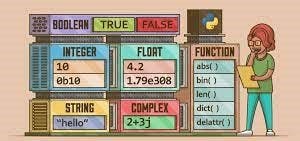🌱What is Python?
Python is a versatile and widely-used high-level programming language known for its simplicity, readability, and ease of learning. Created by Guido van Rossum and first released in 1991, Python has since gained immense popularity among developers, data scientists, and enthusiasts worldwide. Its powerful yet straightforward syntax makes it an ideal choice for various applications, from web development and automation to data analysis and artificial intelligence.
🔅Why Python?
Python's popularity can be attributed to several key factors:

1. Readable and Expressive: Python's syntax is clear and concise, making it easy to read and write. It emphasizes code readability and uses indentation instead of braces, which makes it visually appealing and reduces the chances of errors due to incorrect indentation.
2. Large Standard Library: Python comes with an extensive standard library, providing developers with a wide range of modules and packages to accomplish common tasks without having to write additional code.
3. Versatility: Python is a versatile language, allowing developers to work on various platforms and integrate seamlessly with other languages. It supports both object-oriented and functional programming paradigms.
4. Community and Support: Python has a vast and active community of developers, which means you can find abundant resources, libraries, and documentation to help you solve problems and learn.
5. Beginner-Friendly: Python's easy-to-understand syntax and community support make it an excellent choice for beginners who are stepping into the world of programming.
🚏How to Install Python?
Installing Python is a straightforward process, and you can get started with it on various operating systems. Here's a step-by-step guide to installing Python:
- Check your system:
Before proceeding with the installation, determine if Python is already installed on your computer. Many Linux and macOS systems come with Python pre-installed, but the version may vary.
Open a terminal or command prompt and type the following command:
python --version
If Python is installed, you will see the version number. For example, "Python 3.9.6."
- Download Python:
If you don't have Python installed or need to update to a specific version, head to the official Python website at python.org/downloads.
Python has two major versions: Python 2 and Python 3. As of the time of writing this blog, Python 2 is no longer maintained, and Python 3 is recommended. Therefore, make sure to download the latest Python 3 version available.
- Install Python:
Windows:
Download the Python installer for Windows from the official website.
Run the installer.
On the installation wizard, make sure to check the box "Add Python x.x to PATH" to enable Python from the Command Prompt.
Click "Install Now" to proceed with the installation.
Once the installation is complete, you can verify it by opening the Command Prompt and typing
python --version.
macOS:
Download the Python installer for macOS from the official website.
Run the installer.
Follow the on-screen instructions to complete the installation.
To verify the installation, open the Terminal and type
python3 --version. (On macOS,pythontypically refers to Python 2, whilepython3refers to Python 3.)
Linux:
Most Linux distributions come with Python pre-installed. However, if you want to install a specific version or ensure you have the latest one, you can use your package manager.
For example, on Debian-based systems (ex.Ubuntu), use:
sudo apt update
sudo apt install python3
On Red Hat-based systems (ex.Fedora), use:
sudo dnf install python3
To verify the installation, type python3 --version in the terminal.
- Verify the Installation:
Once Python is installed, you can verify its successful installation by opening a terminal or command prompt and typing python --version (Windows) or python3 --version (macOS and Linux). If the installation was successful, it will display the installed Python version.
You have successfully installed Python on your system and are ready to start coding in one of the most popular programming languages in the world.
🍂Different Data Types in Python.
In Python, data types play a vital role in determining the type of data you are working with. Unlike some other programming languages, Python is dynamically typed, meaning you don't have to explicitly declare the data type of a variable. Instead, Python infers the data type based on the value assigned to the variable. This makes Python an intuitive and user-friendly language for developers of all levels. In this blog, we'll explore the commonly used data types in Python and their characteristics.

- Numeric Types:
Integers (int): Integers represent whole numbers without any fractional parts. They can be positive or negative. For example 5, -10, 1000.
Floating-Point Numbers (float): Floating-point numbers have decimal points and can represent real numbers. For example 3.14, -0.5, 2.0.
- Boolean Type:
Boolean (bool): Booleans represent truth values, and they can only be either True or False. They are used for logical operations and decision-making.
- Sequence Type:
Strings (str): Strings are sequences of characters enclosed in either single or double quotes. They represent text and can include letters, numbers, symbols, and spaces.
For example: "Hello, World!", 'Python'.
Lists (list): Lists are ordered collections of items that can contain elements of different data types. They are mutable, meaning you can add, remove, or modify elements.
For example: [1, 2, 3], ['apple', 'banana', 'cherry'].
Tuples (tuple): Tuples are similar to lists, but they are immutable, meaning that once created, their elements cannot be changed.
They are represented using parentheses.
For example (1, 2, 3), ('red', 'green', 'blue').
- Set Types:
Sets (set): Sets are unordered collections of unique items. They do not allow duplicate elements, and they are mutable.
For example: {1, 2, 3}, {'apple', 'banana', 'cherry'}.
- Mapping Type:
Dictionaries (dict): Dictionaries are collections of key-value pairs, where each key is unique and associated with a value. They are used for fast data retrieval. For example: {'name': 'John', 'age': 30}.
- None Type:
None (NoneType): The special data type None represents the absence of a value or a null value. It is often used to initialize variables or indicate the lack of a return value from a function.
- Range Type:
Ranges (range): Ranges represent an immutable sequence of numbers. They are commonly used in loops and to generate a series of numbers.
For example: range(5) generates 0, 1, 2, 3, 4.
- Bytes Type:
Bytes (bytes): Bytes represent a sequence of bytes. They are often used when working with binary data or when converting strings to bytes.
- Bytearray Type:
bytearray (bytearray): bytearrays are similar to bytes, but they are mutable, allowing you to modify individual elements.
- Complex Type:
Complex Numbers (complex): Complex numbers have both real and imaginary parts. They are represented using the format a + bj, where a is the real part and b is the imaginary part.
Python's flexibility with data types makes it easy to work with various kinds of data and perform operations efficiently. To determine the data type of a variable, you can use the built-in type() function. Understanding data types is crucial in Python programming, as it allows you to write more concise and expressive code, making Python a powerful and popular language for a wide range of applications.
🌷Conclusion:
Python's versatility and ease of use make it an excellent choice for beginners and experienced developers alike. Whether you want to build web applications, analyze data, automate tasks, or dive into machine learning and artificial intelligence, Python has the tools and resources to support your journey.
Happy coding!🍀

